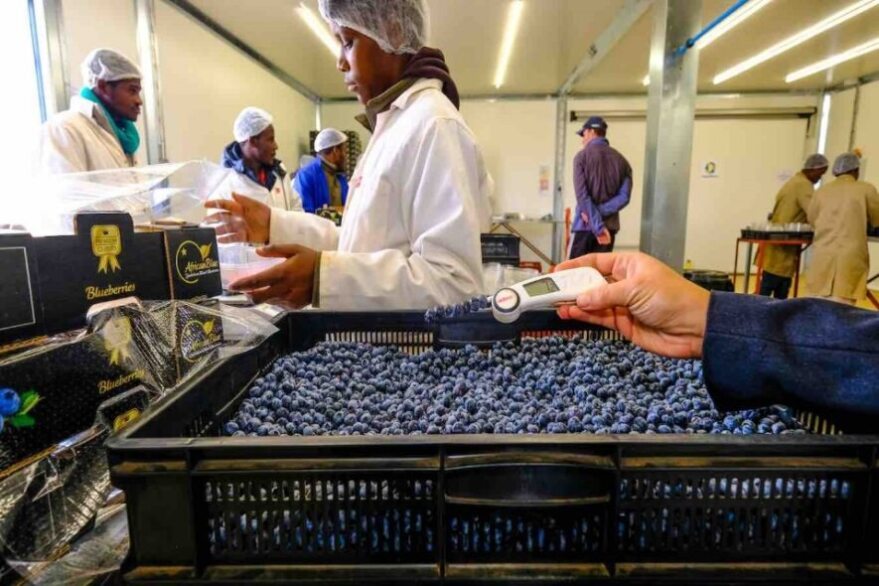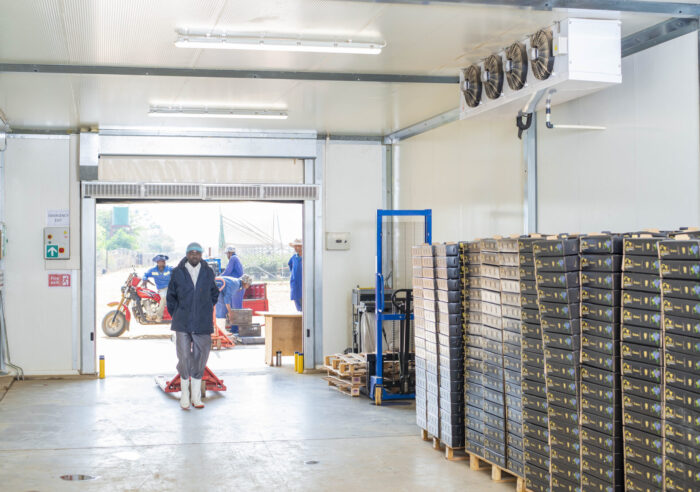5 ways efficient cold chain is addressing challenges for Africa’s fresh produce exporters.
For those in the fresh produce export industry, maintaining consistent quality is of the utmost importance. Yet, several challenges arise, especially in the realm of cold chain management – an essential component for exporters, who aim to thrive in the market. Rising transportation costs, issues of condensation, and maintaining the right on-farm cooling temperatures are some of the prevalent concerns. At InspiraFarms, we’ve developed energy-efficient cooling solutions that address these challenges head-on. Many businesses have already benefited from our innovations. In this article, we outline the industry’s common challenges and showcase how our solutions can drive positive change.
1. Temperature maintenance issues
Exporters of fresh produce in Africa, face significant challenges when maintaining the ideal temperature for their products. Consider the case of Wiserow, a noteworthy example.
Previously, Wiserow operated a cold room with temperatures consistently ranging between 8 to 10 degrees. Achieving and maintaining temperatures below 10 degrees was a persistent issue due to inefficiencies in their cooling solution. As a result, fruits were often dispatched with pulp temperatures between 6 to 8 degrees. For long transit periods by sea freight, the pulp temperature was considered insufficient, as their fruits would often soften in transit, impacting the quality upon arrival.
However, this changed with the adoption of InspiraFarms’ advanced cooling system, which enabled the required pulp temperatures to be met, whilst extending the shelf life of fresh produce. Equipped with efficient in-built blast chillers, the system enabled Wiserow to rapidly achieve and stabilise desired temperatures, often within a timeframe of 30 minutes to an hour.
The efficacy and consistency of the InspiraFarms solution are highlighted here, emphasising the benefits InspiraFarms cooling can bring to exporters. Ensuring product quality during transit is crucial, and with the right cooling system, this becomes a feasible and consistent reality.
2. The impact of soaring air-freight costs
Sea freight has benefits when compared to airfreight, in terms of reaching higher capacity and maintaining much lower prices. Despite sea freight having a longer transit time to key markets, the profitability window for airfreight’s premium is shrinking, making it less lucrative for exporters. Transit time of produce on ships is the predominant challenge for fruit and vegetables, with the duration time from African ports to Europe equating to 25 to 30 days. To successfully reach markets and maintain produce quality, high-quality pre-cooling and an efficient and continuous cold chain from the point of harvest to the consumer, is fundamental.
With increasing airfreight costs, many exporters, like Zimbabwean blueberry exporter Wiserow, have had to shift to sea freight. As of 2022, 30 % of their produce went through air freight, and 70% through the cheaper and longer alternative of sea freight. With the high and rising costs of airfreight, Wiserow has had to send more of its products by sea freight to get a viable return. By sea, their fruits spend almost 25 days in a reefer container and for this reason, good quality precooling has been critical for them to achieve the desired fruit classifications that are required at all stages of the supply chain, from farm level to their final destination on supermarket shelves.
3. Addressing condensation issues
Precooling is the process of treating fresh fruit and vegetables with overpressure airflow (or in certain cases cold water) to remove the field heat straight after harvest and slow down respiration rates before grading, packing, and either storing or shipping. This technique has a positive effect on the shelf life and quality, compared to non-pre-cooled products. Furthermore, not carrying out this process efficiently increases the risk of high condensation rates, which occur when hot, humid air touches colder surfaces. In turn, this generates high risks of molding, shrinkage, and aesthetic defects such as spots, and browning, among others. Yet, a well-designed cold chain is essential to prevent condensation, which can foster the growth of diseases, bacteria, fungi, and yeast.
Our client, Wiserow Enterprises, before the switch, faced frequent condensation issues on their blueberry fruit surfaces, leading to microbial growth and fruit softening. However, with InspiraFarms’ precoolers, Wiserow can use step-down cooling, bringing field heat to 10-12 degrees Celsius before the final cooling, mitigating past condensation issues.

4. Financial losses through claims rejections
Fresh produce exporters might face rejection of their produce or encounter claims for several reasons, including:
- Produce quality and grading issues e.g., physical damage, or evidence of disease.
- Presence of pests or signs of pest activity in the shipment process.
- Non-compliance with standards related to restricted pesticides and contaminants.
- Improper packaging based on the customer’s or importing country’s standards.
- Evidence of temperature fluctuations such as softening, wilting etc.
However, cooling is one of the most common causes of rejection. For Nanyuki-based herb exporter, Bloom Growers, temperature fluctuations in the old cold room resulted in rejections ranging from 40 to 60% and resulting in financial loss. However, with their newly adopted 25msq cold room from InspiraFarms Cooling, they observed nearly zero customer complaints and claims, and have retained more customers due to enhanced produce quality.
This is also the case for Wiserow Enterprises, who received 15 produce loss claims in a year with their old system, which dropped to two with InspiraFarms Cooling’s solutions. After the decline in claims, the business reported an impressive $120,000 of savings on claims alone, highlighting the financial benefits of the cooling upgrade.
5. High cost of power and fuel
For businesses directly dependent on power and fuel, such as energy-intensive cooling, high costs directly increase their operational expenses, reducing their overall profitability. This was the case for Bloom Growers, who initially relied on a diesel-powered generator to run their old cold room costing them between KES 50,000 to 60,000 per week.
They opted for a 25sqm solar-cold room, bringing down their costs of power, close to zero and therefore cutting their costs and improving their operations’ efficiency.
In conclusion
In conclusion, the export of fresh produce alongside farm cooling practices can cause challenges, which, can often seem daunting. Yet, with the right interventions and innovative solutions, these barriers can be effectively addressed. InspiraFarms Cooling is at the forefront of offering such solutions, ensuring that businesses not only navigate these challenges but also thrive in the market. By prioritising quality, efficiency, and sustainability, we aim to empower exporters to deliver the best to their customers, making a tangible difference in the industry’s landscape.



